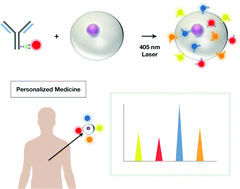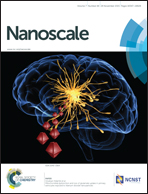Quantum dot multiplexing for the profiling of cellular receptors†
Abstract
The profiling of cellular heterogeneity has wide-reaching importance for our understanding of how cells function and react to their environments in healthy and diseased states. Our ability to interpret and model cell behavior has been limited by the difficulties of measuring cell differences, for example, comparing tumor and non-tumor cells, particularly at the individual cell level. This demonstrates a clear need for a generalizable approach to profile fluorophore sites on cells or molecular assemblies on beads. Here, a multiplex immunoassay for simultaneous detection of five different angiogenic markers was developed. We targeted angiogenic receptors in the vascular endothelial growth factor family (VEGFR1, VEGFR2 and VEGFR3) and Neuropilin (NRP) family (NRP1 and NRP2), using multicolor quantum dots (Qdots). Copper-free click based chemistry was used to conjugate the monoclonal antibodies with 525, 565, 605, 655 and 705 nm CdSe/ZnS Qdots. We tested and performed colocalization analysis of our nanoprobes using the Pearson correlation coefficient statistical analysis. Human umbilical vein endothelial cells (HUVEC) were tested. The ability to easily monitor the molecular indicators of angiogenesis that are a precursor to cancer in a fast and cost effective system is an important step towards personalized nanomedicine.


 Please wait while we load your content...
Please wait while we load your content...